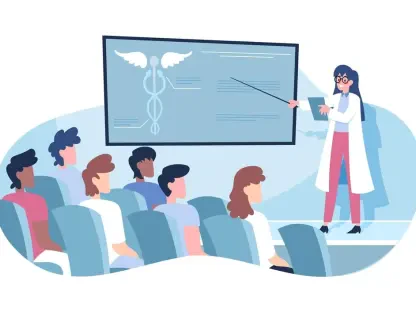Setting the Stage for Healthcare Transformation
In the heart of New York, a staggering reality unfolds: safety net hospitals, the backbone of care for millions of vulnerable residents, struggle under the weight of outdated systems and financial strain, barely managing to keep up with the demands of modern healthcare. These facilities, serving low-income and underserved communities, often lack the resources to keep pace with technological advancements critical for effective healthcare delivery. With a historic $2.6 billion investment announced by state leadership, New York is poised to revolutionize electronic health record (EHR) systems and bolster hospital infrastructure, aiming to bridge disparities and enhance patient outcomes across diverse regions.
This substantial funding signals a turning point for an industry grappling with systemic challenges. The healthcare sector in New York, characterized by a complex network of urban and rural facilities, faces mounting pressure to deliver equitable care while managing limited budgets. Safety net hospitals, in particular, play a pivotal role in addressing these gaps, yet many operate with fragmented technology that hinders efficiency and coordination. This initiative, rooted in strategic partnerships and modernization, seeks to transform how care is provided to the state’s most vulnerable populations.
Overview of New York’s Healthcare Landscape and Safety Net Hospitals
New York’s healthcare system stands as one of the most intricate in the nation, serving a population of nearly 20 million through a mix of world-class medical centers and community-based facilities. Safety net hospitals are indispensable in this ecosystem, providing essential services to low-income, uninsured, and minority groups who often have nowhere else to turn. These institutions address critical needs, from emergency care to chronic disease management, yet they face persistent challenges such as underfunding and staffing shortages that threaten their ability to operate effectively.
The significance of these hospitals extends beyond immediate care, as they are key to reducing healthcare disparities across urban and rural divides. However, maintaining operations often means grappling with outdated infrastructure and limited access to advanced tools, which can compromise patient safety and outcomes. The state government, alongside major players like Northwell Health and Montefiore Health System, recognizes the urgency of supporting these facilities amid evolving technological and regulatory demands.
Influences shaping this sector include stringent compliance requirements and the push for digital integration. State policies increasingly emphasize data-driven care, while federal standards mandate robust privacy and security measures for health information. Regional hospitals must navigate these complexities while striving to meet community needs, making the role of strategic investments and partnerships more critical than ever in sustaining their mission.
Details of the $2.6 Billion Investment in EHR Modernization
Key Components and Strategic Partnerships
Under the Health Care Safety Net Transformation Program, New York has allocated $2.6 billion to modernize EHR systems and strengthen safety net hospitals through a comprehensive framework. Embedded in the current fiscal budget, this initiative prioritizes capital investments, operational enhancements, and regulatory support to ensure long-term viability. The program targets systemic inefficiencies by funding upgrades that align smaller facilities with the capabilities of larger healthcare systems.
Central to this effort are six major partnerships between safety net hospitals and prominent organizations. For example, Centralus Health, formed by Arnot Ogden Medical Center and Cayuga Health, focuses on the Finger Lakes and Central New York regions, aiming to improve behavioral health and ambulatory services. Similarly, Northwell Health collaborates with Crouse Hospital in Syracuse to advance neonatal intensive care and establish cutting-edge cardiac care, while WMC Health integrates Bon Secours Charity Health System to unify digital platforms and expand training programs.
These collaborations emphasize EHR system overhauls alongside infrastructure improvements and service expansions. Investments will enhance access to specialized areas such as maternal health, pediatric care, and mental health support, ensuring that community-specific needs are met. By fostering shared resources and expertise, the state aims to create a more cohesive and responsive healthcare network through these strategic alliances.
Expected Outcomes and Regional Impact
The anticipated benefits of this investment are far-reaching, with improved care coordination at the forefront. Modernized EHR systems promise seamless patient data management, reducing errors and enabling providers to make informed decisions swiftly. Enhanced access to specialized services will also empower communities, particularly in underserved areas, to receive timely and tailored medical attention.
Regional variations play a significant role in shaping the program’s implementation. In western New York, Erie County Medical Center’s partnership with the University of Buffalo Physicians Group targets a community-wide digital health framework to boost primary care access. Conversely, in Brooklyn, Maimonides and NYC Health + Hospitals focus on preserving essential services amid dense urban challenges, illustrating how localized strategies address unique demographic and geographic demands.
Looking ahead, this initiative is expected to fortify New York’s healthcare network by enhancing operational efficiency and patient outcomes. Success metrics may include reduced hospital readmission rates, faster treatment times, and higher satisfaction among patients and staff. As these transformations unfold over the coming years, from 2025 to 2027, the state anticipates a measurable impact on how care is delivered and sustained across diverse communities.
Challenges in Implementing EHR Modernization and Hospital Upgrades
Safety net hospitals face significant hurdles in adopting advanced EHR systems, with financial constraints topping the list. Many of these facilities operate on tight budgets, making the upfront costs of technology adoption daunting, even with state funding. Additionally, the lack of in-house expertise often complicates the integration of sophisticated systems into existing workflows.
Operational disruptions during the transition period pose another concern. Upgrading digital infrastructure can temporarily halt routine services, impacting patient care and staff morale. Aligning diverse healthcare systems under a unified platform further adds to the complexity, as differing protocols and legacy software create compatibility issues that require careful navigation.
To mitigate these obstacles, phased implementations are being prioritized to minimize downtime and ensure gradual adaptation. State support, including technical assistance and funding for staff training, plays a crucial role in easing the burden. Collaboration with experienced partners, such as larger health systems, also offers a pathway to share best practices and resources, smoothing the journey toward modernization.
Regulatory and Policy Framework Supporting the Initiative
The Health Care Safety Net Transformation Program operates within a robust regulatory landscape designed to facilitate systemic change. State policies embedded in the current fiscal budget provide not only funding but also mechanisms for oversight to ensure accountability. These guidelines aim to balance innovation with the practical needs of safety net hospitals, offering a structured approach to transformation.
Compliance remains a cornerstone of EHR implementation, with strict standards governing data security and patient privacy. Adherence to federal regulations, such as those under HIPAA, alongside state-specific mandates, ensures that sensitive information is protected during and after the transition. Hospitals must navigate these requirements meticulously to avoid penalties and maintain public trust.
Regulatory flexibility granted through the program is a key enabler of progress. By easing certain bureaucratic constraints, the state allows partnerships to focus on operational improvements and service delivery rather than administrative hurdles. This adaptability fosters an environment where safety net hospitals can innovate while still meeting essential legal and ethical obligations.
Future Implications for Healthcare Delivery in New York
The long-term impact of this $2.6 billion investment holds promise for reshaping healthcare delivery across the state. By prioritizing sustainability, the initiative aims to create a resilient system capable of withstanding future economic and public health challenges. Equity in care delivery also stands as a central goal, ensuring that underserved populations gain consistent access to high-quality services.
Emerging trends, such as the growing reliance on technology, are set to redefine traditional hospital models. Digital tools and telehealth capabilities, bolstered by EHR upgrades, could shift care toward more proactive and remote solutions. Inter-organizational collaboration, as demonstrated by the current partnerships, may further disrupt conventional silos, paving the way for integrated care networks.
Innovation, guided by state leadership and community input, will likely drive future growth areas. Addressing the unique needs of rural versus urban settings, for instance, could inspire targeted programs for telepsychiatry or mobile clinics. As New York continues to invest in its healthcare infrastructure, the focus on underserved groups ensures that progress aligns with broader social and economic priorities.
Reflecting on a Historic Commitment
Looking back, New York’s $2.6 billion investment in EHR modernization and safety net hospital partnerships marked a defining moment in the state’s healthcare journey. It tackled deep-rooted challenges with a blend of technological innovation and collaborative strength, setting a precedent for systemic reform. The initiative demonstrated a clear resolve to uplift vulnerable communities through tangible improvements in care access and quality.
Moving forward, stakeholders must prioritize continuous evaluation to ensure the program’s goals are fully realized. Establishing clear benchmarks for patient outcomes and operational efficiency will be essential in measuring success. Additionally, fostering ongoing dialogue between state officials, healthcare providers, and local communities can help address unforeseen challenges and adapt strategies as needed.
The path ahead calls for sustained commitment to funding and support, ensuring that safety net hospitals remain equipped to evolve with emerging needs. Exploring opportunities for public-private partnerships could further amplify resources and expertise. Ultimately, this historic effort laid the groundwork for a more inclusive and resilient healthcare system, urging all involved to build on its foundation with creativity and determination.









